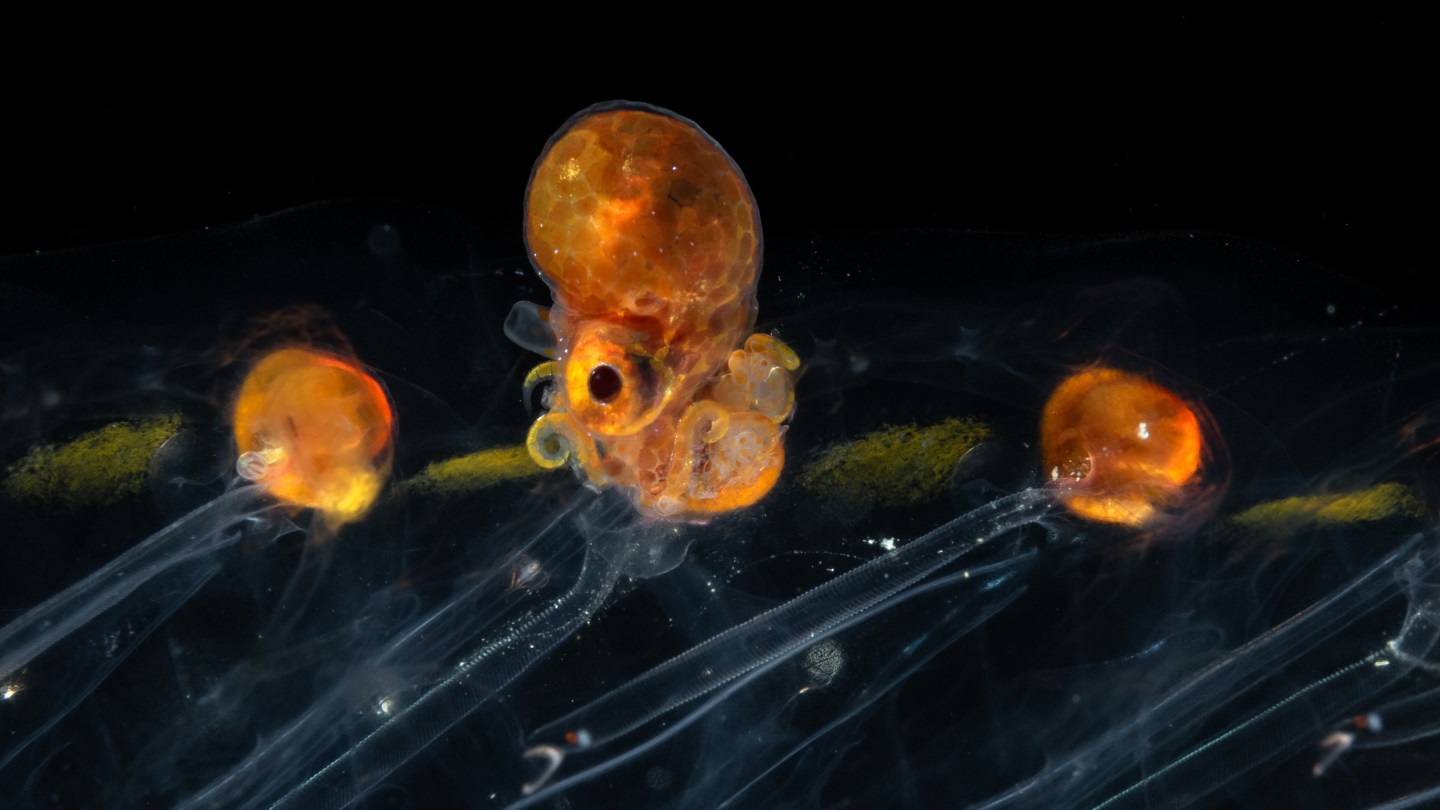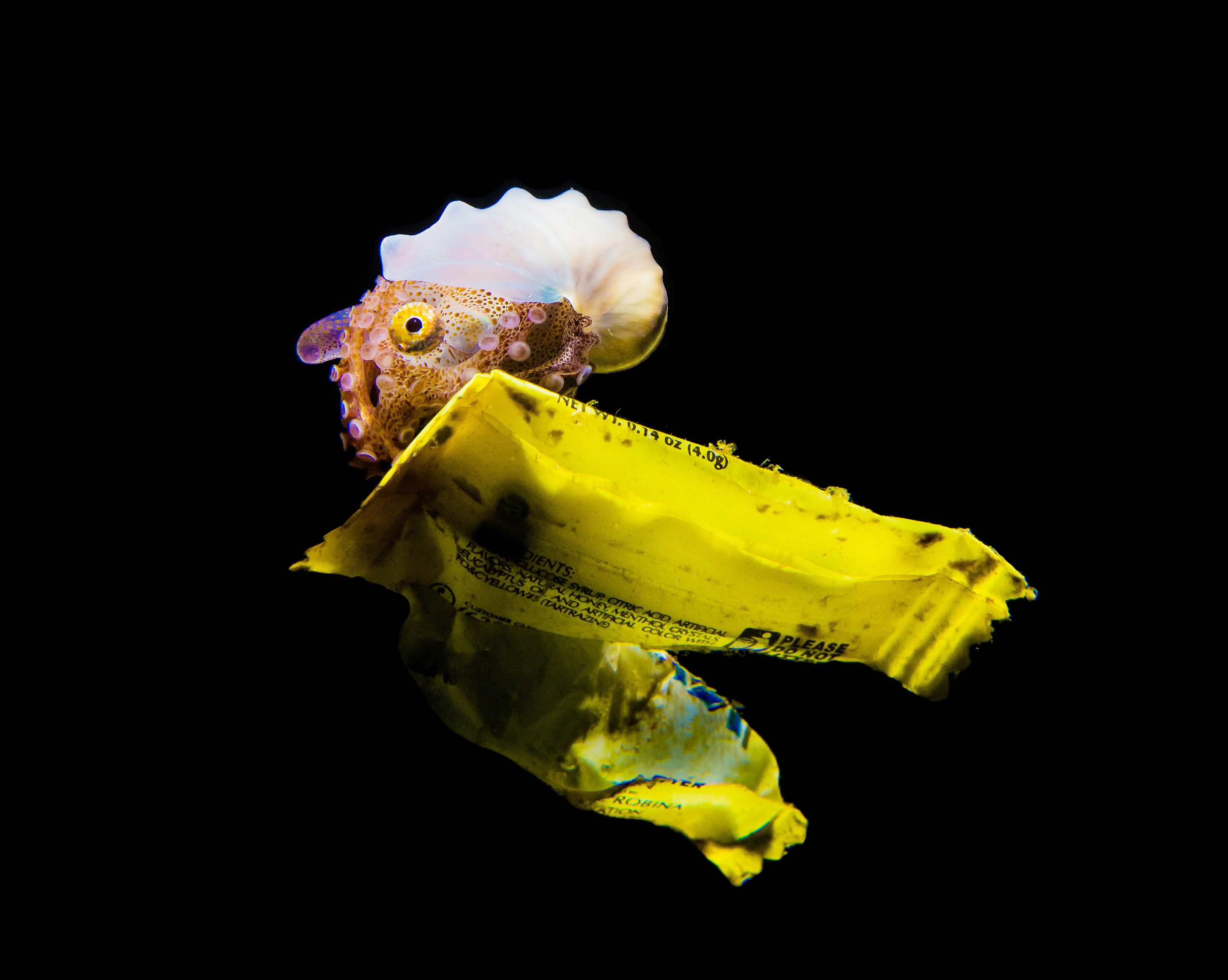In 2019, the photographer Harris Narainen had just wrapped up a night dive off Anilao in the Philippines and begun his staggered ascent to the surface when his dive leader pointed a flashlight at something bright and yellow. Narainen looked over and saw a tiny shelled octopus called an argonaut, or paper nautilus, clinging to the candy wrapper as if it were a magic carpet. "I was just too excited," Narainen wrote in an email. Earlier, the dive leader had mentioned they might see argonauts if they were lucky, and now here one was, sailing into the bright beam of light.
Although most octopuses live near the ocean floor and its ample hiding places, argonauts spend their entire lives sailing in the open ocean, just below the surface. This lifestyle has rendered the small cephalopods rather elusive to the scientists who wish to study them. "Most observations on argonauts are opportunistic," Roger Villanueva, a marine biologist at Spain's Institute of Marine Sciences (CSIC), wrote in an email. In many of these serendipitous observations, argonauts are spotted clinging to some kind of substrate, such as a twig of driftwood or some gelatinous creature. But a traditional sampling net cannot capture these associations; the turbulence of retrieval will separate an argonaut from its trusty steed or entangle it randomly with another.
Fortunately, argonauts are coveted subjects for many blackwater photographers, who dive at night with lights. Many of the creatures drawn to these lights are still in their larval stages, mostly translucent and often bearing little resemblance to their future selves. Villanueva, who has studied cephalopods for over 30 years, is particularly interested in the mystery of their early developmental stages, which "are traditionally poorly sampled and poorly understood compared to adults and offer many unanswered questions," he said.

Villanueva was scrolling through blackwater dive photos on Instagram when he noticed quite a few photos of argonauts, many of which were juveniles, clinging to another organism or floating structure with their suckers. Villanueva and the marine biologists Fernando Á. Fernández-Álvarez and Josep-Maria Gili realized these photos could offer scientists insight into what substrates argonauts commonly prefer. Their analysis of these photos was recently published in the journal Ecology.
The researchers searched hashtags such as #blackwaterdiving and #argonaut, poring over 55,100 photos posted on Instagram posted from 2016 to 2023. After eliminating any photos that were duplicated or seemed altered or manipulated, they were left with 569 photos of argonauts, including large females, tiny males, and juveniles too young to be sexed. This meticulous task was "slow but very satisfying," Villanueva said. Although the researchers were able to identify all four living species of argonauts from the photos of adult, shelled females, the smaller argonauts were recorded as unknown species.
Argonauts exhibit extreme sexual dimorphism, as females weigh up to 600 times as much as males. Females, which can grow longer than 14 inches, secrete a thin, ridged shell that help the octopuses attain neutral buoyancy in the water and protect their eggs. "When a shell is damaged the female argonaut can repair it or completely rebuild when necessary," Villanueva said.

The tiny males never develop a shell, but instead develop a modified arm that he can detach onto a female's mantle to pass along his sperm. This arm can move on its own, wriggling toward the very center of the spiraling shell. This led certain researchers to mistake these lone male arms for "some form of a parasite or worm living inside the female," Villanueva said. A female argonaut can store a handful of these male arms until she is ready to spawn.
After the researchers analyzed the photos, they found that most large females preferred to scoot around on plastic waste, plant debris, and true jellyfish in the class Scyphozoa. The smaller argonauts, however, preferred to cling to free-floating animals called thaliaceans, which include salps and pyrosomes, as well as more delicate jellies in the class Hydrozoa. Overall, the researchers recorded argonauts riding on a vast array of animals, including comb jellies, crustaceans, mollusks, fishes, and even other argonauts.
Scientists still aren't sure exactly why argonauts spend so much of their lives hitchhiking. One obvious benefit appears to be transportation: sitting on top of a jellyfish means moving takes less effort. Argonauts might also feed on the amphipods and other crustaceans that dwell within a gelatinous animal like a salp. And some photos suggested the argonauts might also camouflage themselves in these associations, the orange beads of their bodies nearly indistinguishable from the orange stomachs of a salp. When the photographer Ryo Minemizu glimpsed a male argonaut about 40 feet below the surface off Anilao, he spotted a winged argonaut perched atop a jellyfish, Eutiara decorata. "Even as I approached, the Argonaut showed no signs of letting go of the jellyfish, almost as if it were pretending to be part of it," Minemizu wrote in an email.

Argonauts are not the only octopuses that spend their days catching free rides from squishier organisms. Small pelagic football octopuses have been reported living inside the twin-tailed salp, Villanueva said. And the shimmering, iridescent blanket octopus is known to carry shards of the stinging tentacles of man o' wars. Scientists still don't know why the octopus hoards these weapons, and if the tentacles help the cephalopod capture prey or defend against predators. And although octopuses are famously solitary animals, female argonauts sometimes associate with each other, clinging together in a chain of up to 18 female argonauts. The exact reason for this behavior also remains unknown, Villanueva said.
Unsurprisingly, the researchers' survey also revealed argonauts have recently taken advantage of a new type of substrate. "Plastic has already become a new substrate used by argonauts in the Anthropocene era to navigate in surface ocean waters, illustrating the urgent need to reduce plastic pollution in the ocean," Villanueva said. The researchers observed female argonauts chose to raft on plastics, which are similarly inert to their preferred rafts of leaves and true jellyfish.
When Narainen's dive guide noticed a female argonaut drifting on the candy wrapper off Anilao, the guide went to remove the plastic wrap so Narainen could take a better photo. But Narainen knew the argonaut needed to hitchhike to move throughout the water, and asked the guide the leave the argonaut alone. "She chose a plastic candy wrap," he said. "I wanted to show the sad truth of pollution in our ocean," he added. So he snapped a photo and let her sail on, into the black depths of the night.






